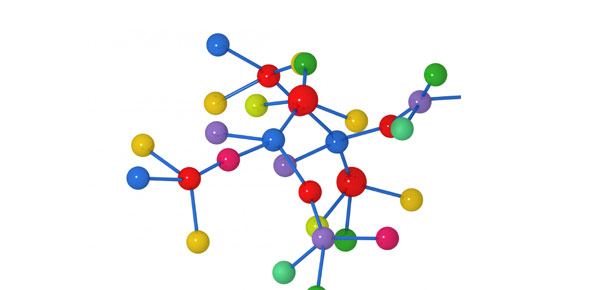Organic Molecules

Basics of organic molecules.
Covers carbohydrates, lipids, proteins, and nucleic acids.
- 1.
Carbohydrates are
- A.
Polar
- B.
Nonpolar
- C.
Hydrophobic
- D.
Made up of carbon, oxygen, and an r group
- E.
Amphipathic
Correct Answer
A. Polar -
- 2.
Eicosanoids are
- A.
Six carbon rings
- B.
Nonpolar
- C.
Lipophilic
- D.
Involved in intercellular communication
- E.
Amphipathic
Correct Answer
D. Involved in intercellular communication -
- 3.
Lipids are
- A.
Made of six carbon rings
- B.
Hydrophilic
- C.
Amphipathic
- D.
Simple sugars
- E.
Polar
Correct Answer
C. Amphipathic -
- 4.
Eicosanoids are modified fatty acids composed of _____ carbon rings
Correct Answer
five - 5.
Phospholipid heads are
- A.
Polar, hydrophilic,and lipophilic
- B.
Nonpolar, hydrophobic, and lipophilic
- C.
Polar, hydrophobic, and lipophobic
- D.
Nonpolar, hydrophobic, and lipophilic
- E.
Polar, hydrophilic, and lipophobic
Correct Answer
E. Polar, hydrophilic, and lipophobic -
- 6.
Steroids
- A.
Are nonpolar
- B.
Contain five carbon rings
- C.
Function as hormones
- D.
Are modified fatty acids
- E.
Are hydrophobic
Correct Answer
C. Function as hormones -
- 7.
Lipids and triglycerides are bot considered to be hydro____.
Correct Answer
phobic - 8.
___________ form bilayers and micelles.
- A.
Polysaccharides
- B.
Steriods
- C.
Disaccharides
- D.
Triglycerides
- E.
Phospholipids
Correct Answer
E. Phospholipids -
- 9.
Polypeptides are formed by ______ bonds.
- A.
Covalent
- B.
Peptide
- C.
Nonpolar
- D.
Polar
- E.
Hydrogen
Correct Answer
B. Peptide -
- 10.
________ are broken into primary, secondary, tertiary, and quartenary structures.
Correct Answer
Amino acids - 11.
DNA is
Correct Answer
deoxyribonucleic acid - 12.
Steroids are very stable, because they are composed of 3 ________.
Correct Answer
six carbon rings - 13.
R group also means ______ group.
Correct Answer
residual - 14.
RNA is
Correct Answer
ribonucleic acid - 15.
Polymers of nucleotides are
- A.
Lipids
- B.
Proteins
- C.
Amino acids
- D.
Nucleic acids
- E.
Carbohydrates
Correct Answer
D. Nucleic acids -
- 16.
Phospholipid tails are
- A.
Polar, hydrophobic, and lipophilic
- B.
Nonpolar, hydrophobic, and lipophilic
- C.
Polar, hydrophilic, and lipophobic
- D.
Nonpolar, hydrophilic, and lipophobic
- E.
Polar, hydrophilic, and lipophilic
Correct Answer
B. Nonpolar, hydrophobic, and lipophilic -
- 17.
__________ are composed of a five carbon carbonate, nitrogenous base, and a phosphate group.
Correct Answer
Nucleotides - 18.
The polarity of a steriod is
- A.
Polar
- B.
Nonpolar
- C.
Slightly charged
- D.
Neutral
- E.
Amphipathic
Correct Answer
E. Amphipathic -
- 19.
The most useful steriod is ______.
Correct Answer
cholesterol - 20.
The polarity of the triglycerides is
- A.
Polar
- B.
Nonpolar
- C.
Amphipathic
- D.
Slightly charged
- E.
Neutral
Correct Answer
B. Nonpolar -
- 21.
Steroids are found in the
- A.
ICF
- B.
ISF
- C.
Plasma membrane
- D.
ECF
- E.
Urine
Correct Answer
C. Plasma membrane -
- 22.
Starch and cellulose are examples of _____.
Correct Answer
polysaccharides - 23.
The subunits of polysaccharides are
- A.
Glucose and glycogen
- B.
Glucose and ribose
- C.
Sucrose and lactose
- D.
Lactose and glycogen
- E.
Sucrose and glycogen
Correct Answer
A. Glucose and glycogen -
- 24.
Carbohydrates are composed of
- A.
Carbon, hydrogen, and nitrogen
- B.
Hydrogen and oxygen
- C.
Oxygen, nitrogen, and carbon
- D.
Carbon, hydrogen, and oxygen
- E.
Carbon and glucose
Correct Answer
D. Carbon, hydrogen, and oxygen -
- 25.
Carbohydrates are hydro____.
Correct Answer
philic - 26.
All are examples of monosaccharides except for _____.
- A.
Glucose
- B.
Fructose
- C.
Lactose
- D.
C6H1206
- E.
Galactose
Correct Answer
C. Lactose -
- 27.
Simple sugars are also called ______.
Correct Answer
monosaccharides - 28.
Carbohydrates do not bond to ______ molecules.
Correct Answer
water - 29.
Sucrose and lactose are examples of ________.
Correct Answer
disaccharides - 30.
Lipids are linked by ______ covalent bonds.
- A.
Polar
- B.
Amphipathic
- C.
Peptide
- D.
Nonpolar
- E.
Hydrogen
Correct Answer
D. Nonpolar -
- 31.
Triglycerides dissolve in _______ solvents.
Correct Answer
nonpolar - 32.
___________ are composed of carbon, an amino group, carboxyl group, hydrogen, and an R group.
Correct Answer
Amino acids - 33.
Triglycerides are composed of ______ and _________.
- A.
Glycerol and glycogen
- B.
Glucose and glycogen subunits
- C.
Phosphate group, gycerol, and fatty acids
- D.
Glycerol and fatty acids
- E.
Fatty acids and glucose
Correct Answer
D. Glycerol and fatty acids -
- 34.
________ are composed of a phosphate group, choline, glycerol, and fatty acids.
Correct Answer
Phospholipids - 35.
Lipids usually contain ______.
Correct Answer
phosphates
Quiz Review Timeline +
Our quizzes are rigorously reviewed, monitored and continuously updated by our expert board to maintain accuracy, relevance, and timeliness.
-
Current Version
-
Jul 30, 2011Quiz Edited by
ProProfs Editorial Team -
Feb 06, 2010Quiz Created by
Wrig7758
- Atomic Theory Quizzes
- Chemical Bonding Quizzes
- Chemical Compound Quizzes
- Chemical Element Quizzes
- Chemical Reaction Quizzes
- Chemistry Practice Quizzes
- Clinical Chemistry Quizzes
- Electrolysis Quizzes
- Functional Group Quizzes
- Gas Quizzes
- General Chemistry Quizzes
- IBSL Chemistry Quizzes
- Medicinal Chemistry Quizzes
- Periodic Table Quizzes
- Rate Of Reaction Quizzes
- Reaction Quizzes
- Soap Quizzes
- Solution And Mixture Quizzes
- State Of Matter Quizzes
- Stoichiometry Quizzes
 Back to top
Back to top


